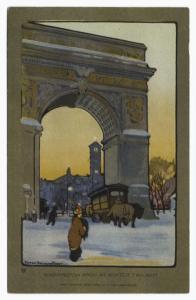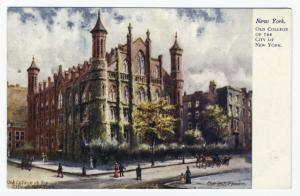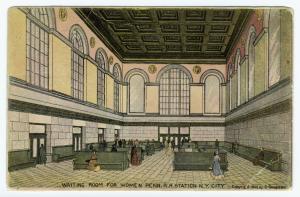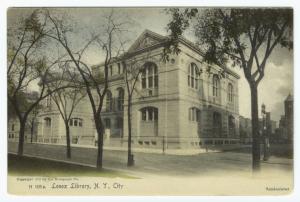The Central Libraries > Mid-Manhattan
Library > Historical Postcards
A Record of Art
 Washington Arch at winter twilight.
Washington Arch at winter twilight.
Digital ID: 836197 Early postcards were typically printed in Germany,
where the art of lithography had reached a level
of refinement and cost-effectiveness not found
elsewhere. The high quality of printing enticed
the public to collect the cards, and assured artists
that their work would be reliably and attractively
reproduced. Art reproductions were finally within
the reach of the populace, who avidly filled albums
with their favorite images. Postcard publishers
commissioned battalions of artists to fill the
demand. Inspiration was plentiful enough
on the streets of New York.
Rachael Robinson Elmer, daughter of an old
Vermont family of Quaker farmers, abolitionists,
naturalists and artists, gained fame for
two sets of fine art postcards depicting New
York. Washington Arch at Winter Twilight is
from the first set, published in 1914 by P.F.
Volland Company. Two years later, she issued
the second set—linocuts with an art moderne
feel—on her own, publicizing the event
with a poster. Views
of Grant’s
Tomb and the Woolworth
Building on a June night are examples of
the second set.
 Old College of the City of New York.
Old College of the City of New York.
Digital ID: 836437The firm of Raphael Tuck, the most prolific British
publisher of postcards, commissioned several series
of New York views from painters working in oil. These
postcards were dubbed “Oilettes.” This
painting of the Old College of the City of
New York (the first home of CCNY)
was done by Charles F. Flower, one of the foremost
of Tuck’s artists.
 Stokes Grove Street Studio.
Stokes Grove Street Studio.
Digital ID: 836699
Bernhard Wall designed over 5000 comic postcards, earning
the title of “Postcard King.” After
1915, he devoted himself more seriously to etching.
This rendering of the Greenwich Village studio
of the painter and welfare worker Helen Olivia
Phelps Stokes is an example of his later work.
 Waiting room for women Penn R.R. station.
Waiting room for women Penn R.R. station.
Digital ID: 836931
The artist of this 1908 lithograph of the waiting
room for women in the now demolished Penn Station,
identified in the caption as S. Goodman, may have
self-published the card. Anyone could be
a postcard publisher, and many artists, both prominent
and obscure, took advantage of this small medium
to showcase their talents. Particularly noteworthy
is the patterning of the dresses on the women who
wait.
 The Astor Library, N. Y. City
The Astor Library, N. Y. City
Digital ID: 836719
The
historical postcards also document the art of architecture
with a rich supply of images of buildings still
thriving and long since demolished. The Lenox
Library, a Greek Revival Building on Fifth Avenue
and East 71st Street designed by Richard Morris
Hunt, was demolished in 1913 to make way for the
mansion that now houses the Frick Collection. Two
years earlier, The New York Public Library moved
the collections of the Lenox Library to join the
Astor Library and Tilden Foundation collections
in a splendid new structure built by Carrere
and Hastings on the corner of 42nd and Fifth.

The New York Public Library
from a pencil drawing
by Louis H. Ruyl
Digital ID: 836813